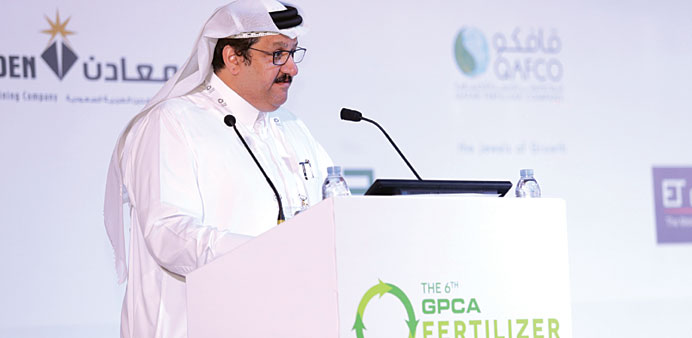Al-Sowaidi delivers the keynote speech at the “6th Fertiliser Convention” held in Dubai.
While fertiliser producers in the GCC have achieved many milestones in the last decade, growing global population and increased food production are among the challenges the fertiliser sector needs to address, an industry expert said.
Qatar Fertiliser Company (Qafco) chief executive officer Khalifa al-Sowaidi said the global fertiliser industry is expected to grow by 1.8% annually until 2018 “yet, there are demographic and economic challenges in the horizon.”
Sowaidi made the statement during his keynote speech during the “6th Fertiliser Convention” hosted by the Gulf Petrochemicals and Chemicals Association (GPCA) in Dubai.
“From the current 7bn, the global population will reach 9.7bn by 2050, with growth coming from Asia and Africa. The biggest challenge for leaders around the world is feeding this huge population,” said al-Sowaidi, who is also the chairman of the GPCA’s fertiliser committee.
He added: “We estimate that food production will need to increase by 70% to feed these people yet, net arable land in this period will rise by just 5%.”
Sowaidi said the GCC is a major global exporter of urea and ammonia. “Traditionally, the margins for GCC producers are healthy due to access to favorably priced gas, a key raw material in the production of fertilisers,” he explained.
According to the latest GPCA research, producers in the Arabian Gulf manufacture 40.9mn tonnes of fertilisers, a capacity that has grown by 102% since 2004. An exported-oriented industry, which trades up to 22.9mn tonnes of products to diverse markets, including North America, Asia, and the Far East, the sector earned $6.5bn in revenues in 2014.
“And for regional fertiliser producers, a majority of which are government-owned, there are also economic challenges ahead. The global fertiliser capacity is increasing so the GCC fertiliser industry might be in a position of oversupply, which will drive prices down. “An additional challenge is the possibility of a nuclear deal with Iran, which could bring more oil to world markets, resulting in continuing low oil prices of the oil exporting GCC states,” al-Sowaidi stressed.
Despite looming capacity shortfalls in the long- term, “fertilisers will continue to be critical to the survival of the human race,” according to Agriculture Service director Patrick Heffer of the International Fertiliser Industry Association. “Without fertilisers, we would hardly be able to feed more than 4bn people. Without fertilisers, we would need 1.2bn hectares of land to produce just cereal. This area is something we do not have,” Heffer said.
GPCA secretary general Dr Abdulwahab al-Sadoun said the GCC fertiliser industry must find strategies to meet demand for diverse markets, while remaining “competitively priced.”
“In the last decade, the fertiliser industry in the Arabian Gulf grew into a multi- billion dollar sector employing 51,000 people. However, with demographic and economic challenges, the era of large capacity growth with high profits is drawing to a close as competitors have access to favorably priced gas, an advantage that has traditionally served this region’s petrochemicals industry well,” al-Sadoun said.
He added: “Therefore, GCC fertiliser producers must look into diversifying their portfolio to include high- value products. With the imminent launch of Saudi Arabia’s Waad Al Shamaal Phosphate City, and a small but growing specialty fertiliser industry, the good news is that the region is already well on its way to overcoming these challenges.”



